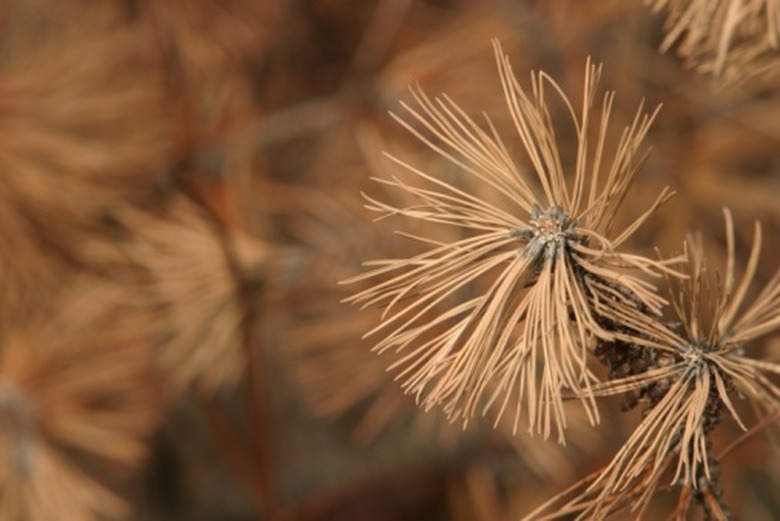Why Is My Pine Tree Dying From The Bottom Up?
We may receive a commission on purchases made from links.
Some pines (Pinus spp.), like ponderosa (Pinus ponderosa, USDA zones 3-7) and Scotch (Pinus sylvestris, zones 2-8), drop needles growing on the lower branches. This is a normal sign of aging and doesn't mean that the tree is dying. Other pine tree species also drop old needles, replacing them with new growth at the tips of the branches. Check your tree to see where the dropped needles are coming from. If one-fourth to one-third of the needles on the inner part of the branches are falling off, it's normal aging. However, if your pine is shedding new needles at the tips of its branches, it could be infected with a disease.
Tip
If your pine tree is shedding new needles at its branch tips and appears to be dying from the bottom up, it may have one of several common plant diseases that typically attack conifers.
Brown-Spot Needle Blight
Brown-Spot Needle Blight
Brown-spot needle blight is a fungus that attacks more than 30 species of pines. The most obvious symptom is the appearance of spots on the needles. The most common is a straw-yellow spot that's 1/8 inch in diameter, but brown spots on an amber-yellow band are also possible. The tissue between the bands or spots usually remains green. In both cases, the spots have strongly defined margins, unlike spots caused by other needle diseases. Infected needles die from the tips back, until the entire needle is dead.
Infected needles on Scotch pines are typically found on the lower branches. Although severe infections can kill branches, the buds usually remain healthy and produce new needles in the spring. New needles may also become infected. Brown spot can be treated chemically, usually by a copper-based fungicide. Consult your local county extension service for information about treatment; it varies, depending on the species of pine.
Needle Cast Disease
Needle Cast Disease
Needle cast disease can cause pine needles to turn yellow or brown from the bottom of the tree up. Although this fungus doesn't usually kill trees, they are weakened by it and so become more susceptible to other diseases and to insect attack. Over 40 species of fungi are responsible for needle cast, and fungal spores are spread by splashing rain and wind.
Needles turning brown in late fall or early spring are a sign of this disease. Fungicides can be used to treat this disease, but it's not recommended. Instead, homeowners should collect and destroy infected needles to reduce transmission.
Diplodia Tip Blight
Diplodia Tip Blight
Diplodia tip blight (formerly known as Sphaeropsis tip blight) usually infects trees that are at least 15 or 20 years old when they start producing cones. The diplodia fungus colonizes the female cones and release spores whenever it rains. These spores infect and kill young shoots, resulting in sprays of stunted and dead needles at the tips of lower branches.
Although the lower branches die first, most of the other branches will eventually be affected, and the entire tree can die. Diplodia spreads quickly in wet spring weather. A fungicide spray program can save even heavily infected trees, if repeated over several years.
Dothistroma Needle Blight
Dothistroma Needle Blight
An outward symptom of Dothistroma needle blight is the appearance of yellow-orange to brown bands around the needles. The bands can be water-soaked. The needles die and turn brown from the infection point to the tip. Infected needles drop from the tree, and heavy damage can occur in just two or three weeks after the disease first appears.
Dothistroma starts on the lower branches and causes limb death. Austrian (Pinus nigra, zones 4-7) and ponderosa pines are particularly susceptible to this fungus. Trees usually respond to a fungicide spray program that's repeated over several years.
